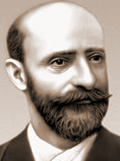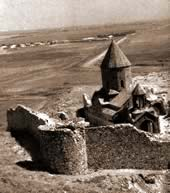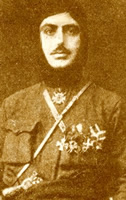Glossary (Mokk – Njdeh)
Mokk
Historical province of the Greater Armenia, one of 15 ashkars or worlds. Mokk consisted of 9 cantons: Eshayr, Mius Eshayr, Eshuts gavar, Arvenits dzor, Mija, Arandznak Mokk, Arkayits gavar, Argasaovit and Germadzor.
Moses Eghvardetsi
Catholicos of Armenia (574-604). Under his patriarchate the Georgian archbishop Kurion proclaimed the Georgian church independent from the Armenian Church. In 584, Moses abolished the lunar calendar, which was in use in Armenia, and adopted a new calendar based on the solar cycles. The new Armenian chronology was established beginning from AD 551.
Moses Kaghankatvatsi
Armenian historian of the 10-th century. His work History of Aghuank is a precious source describing the events of the 4-10-th centuries.
Moses Khorenatsi
 St. Movses Khorenatsi, painting by Hovnatan Hovnatanian (1730-1801)(Moses of Khoren) (approx.410-490), Armenian scholar, Father of the Armenian Historiography. His influential Armenian History covers the vast period from the origins of the Armenian nation to the 5-th century, providing extensive information on ancient Armenian mythology and pagan traditions. However, this work, that affected generations of Armenian writers, became a controversial subject with a number of modern researchers, who believed that Moses of Khorene may have lived in the 7th and even in the 9th century.
St. Movses Khorenatsi, painting by Hovnatan Hovnatanian (1730-1801)(Moses of Khoren) (approx.410-490), Armenian scholar, Father of the Armenian Historiography. His influential Armenian History covers the vast period from the origins of the Armenian nation to the 5-th century, providing extensive information on ancient Armenian mythology and pagan traditions. However, this work, that affected generations of Armenian writers, became a controversial subject with a number of modern researchers, who believed that Moses of Khorene may have lived in the 7th and even in the 9th century.
Muratsan
 Muratsan
Muratsan
(1854-1908) Grigor Ter-Hovannissian, writer, native of Shushi. He treated historical subjects in his dramas and novels. His major works are Rusan and Gevork Marzpetouni.
Musa Dagh
(Musa-Ler) Mountain and village in Cilicia. In the time of the Armenian Genocide in July of 1915, the Armenians of Musa-Dagh organized a desperate resistance and held out against the Turkish siege in a dramatic fight for survival. French navies then rescued those remained alive. The heroic defense of Musa-Dagh was pictured by the Austrian novelist Franz Werfel.
Mush
City on the left shore of River Euphrates (present-day Turkey). Mush was the central city of the historical Taron canton of the Turuberan province of the Greater Armenia.
Nakharar
In ancient and medieval Armenia: a noble of the highest rank, feudal superior.
Nakhichevan
Armenian for: The first settling place (relative to Noah who, after the flood, descended from the Ararat Mountain in Armenia). Said to be the oldest of the Armenian cities, Nakhichevan made part of the Ayrarat, Vaspurakan and Siounik provinces of Armenia. In modern times, Nakhichevan was part of the Yerevan Guberniya (1849-1918), and the First Republic of Armenia (1918-1920). Following the Treaty of Moscow signed by the Bolshevik Russia and Turkey in 1921, Nakhichevan was attached to the Soviet Azerbaijan. In 1924, an autonomous Republic of Nakhichevan was formed within the Azerbaijan Soviet Republic. During the Soviet-Azeri rule the region was entirely cleansed of Armenians.
Nalbandian, Mikael
 Mikael Nalbandian
Mikael Nalbandian
(1829-1866) Armenian patriot, political thinker, poet and public figure. His poem Mer Hayrenik (Our Homeland) is the present national anthem of Armenia.
Nerses Lambronatsi
(1153-1198) Diplomat and theologian, Archbishop of Tarsus in Armenian Cilicia. He wrote a number of works on theological subjects.
Nerses Snorhali (the Graceful)
 Nerses Shnorhali, pictured on a 1321 miniature from Ani
Nerses Shnorhali, pictured on a 1321 miniature from Ani
(1100-1173) Nerses IV the Graceful, Catholicos of Armenia (1166-1173). He was outstanding theologian, poet, prose-writer and sacred music composer. His extraordinary erudition was well known far beyond Armenia.
Nerses the Great
Catholicos of Armenia (353-373). Historians eulogize him for his activities in charity and church building. He abolished some of the old religious rites. To ensure support against Persia, he traveled several times to the Roman Emperor Constantius II and the Roman governor Valens. In 373, Nerses was allegedly poisoned by King Papes.
Nerses III
 The churches of the Holy Virgin and the Holy Illuminator were erected in 1661 at the site of the old Monastery of Khor Virap (Deep Dungeon) built by Nerses III in the 7th century.
The churches of the Holy Virgin and the Holy Illuminator were erected in 1661 at the site of the old Monastery of Khor Virap (Deep Dungeon) built by Nerses III in the 7th century.
Catholicos of Armenia (641-662). He was called the Builder for his outstanding building activities. Nerses III built the monastery of Khor Virap on the very place of the pit where the King Tiridates had kept Gregory the Illuminator as prisoner. Another of Nerses’s famous creations was the marvelous Temple of Zvartnotz.
New Julfa
Armenian quarter of Esfahan, in Iran. Esfahan was the ancient capital of the Persian Shah Abbas I (1587-1629). He encouraged commerce, granting privileges to the merchants and skillful workmen. He displaced here a large number of Armenians, who later formed an important and prosperous colony.
Njdeh
 Garegin Njdeh, photographed in 1919(1886-1955) Garegin Ter-Harutiunian, Armenian statesman, military, and political thinker, native of Nakhcichevan. Member of Dashnak party, he was involved in revolutionary activities in Armenia, Bulgaria and Russia. In 1912, together with General Andranik he formed an Armenian bataillon to fight against the Turks in the Balkan war. Later, moving back to Armenia, Njdeh commanded different military units. He played an outstanding role in organizing the defense of Karakilis in 1918. Convinced Anti-Bolshevik, he led the defense of Zanguezour in 1921. Following the declaration of independence of Zanguezour from the Soviet Armenia, he was proclaimed Prime-Minister and Minister of Defense. He fled Armenia after the triumph of Bolsheviks, and was involved in patriotic activities in Iran, Bulgaria and USA. Controversial figure, he was expelled from Dashnak party. Staunch Anti-Communist, he came to collaborate with Natzi Germans during the WWII. He was arrested in Sophia, Bulgaria in 1944 and sent to Moscow, then to Yerevan, where he died in prison.
Garegin Njdeh, photographed in 1919(1886-1955) Garegin Ter-Harutiunian, Armenian statesman, military, and political thinker, native of Nakhcichevan. Member of Dashnak party, he was involved in revolutionary activities in Armenia, Bulgaria and Russia. In 1912, together with General Andranik he formed an Armenian bataillon to fight against the Turks in the Balkan war. Later, moving back to Armenia, Njdeh commanded different military units. He played an outstanding role in organizing the defense of Karakilis in 1918. Convinced Anti-Bolshevik, he led the defense of Zanguezour in 1921. Following the declaration of independence of Zanguezour from the Soviet Armenia, he was proclaimed Prime-Minister and Minister of Defense. He fled Armenia after the triumph of Bolsheviks, and was involved in patriotic activities in Iran, Bulgaria and USA. Controversial figure, he was expelled from Dashnak party. Staunch Anti-Communist, he came to collaborate with Natzi Germans during the WWII. He was arrested in Sophia, Bulgaria in 1944 and sent to Moscow, then to Yerevan, where he died in prison.







